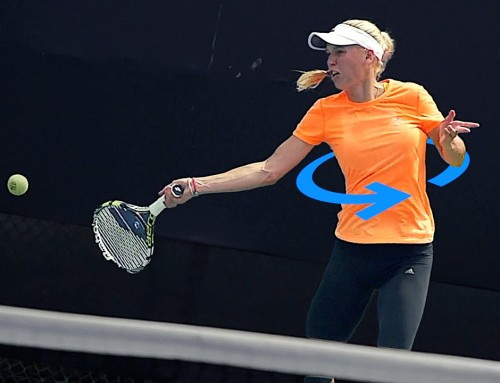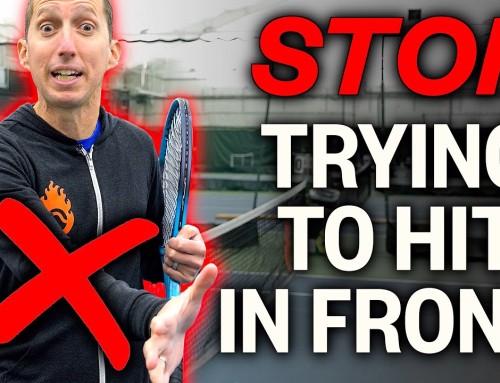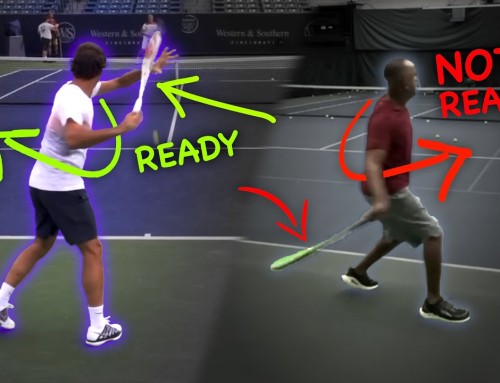I had an incredible session with one of my students, Susan, and we discovered something that completely changed how she thinks about her forehand and how to control both flat and topspin forehands.
She hits with a ton of topspin. Like, a LOT of spin.
But here’s the thing: she wanted more options. She wanted to be able to drive the ball flat when the opportunity arose, not just hit heavy topspin shots all day long.
What we uncovered during this lesson is something every tennis player needs to understand about their forehand.
There are two forces at work every single time you swing at a tennis ball.
The first force is your body rotation. The second is your racket path.
And here’s what’s wild: most players only think about one of them.
Let me tell you what I mean by breaking down some footage of Roger Federer. I pulled up a video of him warming up, just casually hitting forehands at the beginning of practice.
By the time he makes contact, his hips are parallel to the baseline and his shoulders are actually past parallel. He’s made a complete ninety degree turn from his setup position to contact.
This is huge because it means his arm can be totally relaxed. All that energy is coming from his body rotation. If the body doesn’t provide that energy, then something else has to propel the racket forward, and that something ends up being your arm.
That’s when things get quick and flippy and tense.
Now here’s where it gets really interesting for you: mastering the racket path for flat and topspin control.
The second force is your racket path, and this is where most players get stuck hitting only one type of forehand.
Look at Roger’s contact point in that warmup footage. Now look at the lowest point his racket drops to before he swings forward. It’s probably right about hip level.
Draw a line between those two points and you get the path he’s swinging on. He’s got a bunch of forward energy and just a little bit of upward energy.
If swinging straight up was one hundred percent vertical and swinging straight forward was one hundred percent horizontal, Roger’s path is probably twice as forward as it is upward.
That means he’s going to create some topspin, but most of his energy is being delivered into the ball forward. Lots of penetration with a little bit of shape.
Now compare that to Rafael Nadal.
Rafa comes from way lower below the ball and swings upward much more steeply. That’s why his finish wraps around his body so dramatically. He’s accelerating way more of his energy vertically, which is exactly why his topspin numbers are off the charts compared to everyone else.
It all comes down to the path.
Here’s what you need to understand: if you want to hit a heavy topspin ball, your racket needs to drop low before you start your forward swing. Really low. Then you swing upward steeply toward the ball.
That creates about a fifty fifty split between upward and forward energy.
Massive amounts of topspin, lots of curve, but less penetration.
But if you want to drive the ball with pace and flatten it out, your racket should only drop to about the height of the incoming ball. That creates a much more level swing path, delivering more energy forward through the ball with way less upward brushing action.
Less spin. More drive.
Think about your own game. Which type of forehand are you locked into?
If you’re hitting everything heavy with tons of spin, you’re probably dropping your racket really low and coming up steep. If you’re shanking balls or hitting everything flat without much margin, you might not be dropping low enough to create any upward path at all.
The key is learning to control both extremes: how to practice different forehand swing paths.
When you practice this, start by shadowing the movements without a ball. First, practice the heavy topspin path with the lowest drop and the steepest rise. Then practice the flat drive where your racket only falls to ball height and swings mostly level.
Feel the difference in your body. Notice how much more your arm has to work on the heavy ball versus how much your body rotation does the work on the flat drive.
When you start hitting actual balls, here’s what’s going to happen: your heavy topspin shots might sail long at first. That’s not a path problem, that’s a face problem.
Remember this: the face sends it, the path bends it.
If your ball goes too far, you need to close the racket face angle slightly. Just turn your hand a bit and adjust the strings to point down more. We’re talking about three or four degrees of difference.
That’s it. Three or four degrees is the difference between a ball that floats long and one that dips perfectly into the court.
When you switch to the flat path, you’ll feel the ball jump off your strings differently. The racket falls only to ball height, the swing is mostly level with just a touch of low to high, and all your force goes straight through the ball.
No curve. Just pure penetration.
Now, would you hit that dead flat laser all the time? Probably not. That shot is for when you’re timing everything perfectly, you’re having your best day ever, and you need to absolutely pound the ball to win the point.
For most shots, you want a path somewhere in between. A little more margin than the laser, but way more drive than the super heavy topspin ball.
The whole point here isn’t to make you abandon whatever forehand you’re comfortable with right now.
The point is to give you options so you’re not locked into just one way of hitting.
Are you only comfortable hitting one type of shot? Do you know how to manipulate your racket path to create different amounts of spin and drive?
Most players never think about this stuff consciously. They just swing the same way every time and wonder why they can’t adjust when the situation calls for something different.
Your body rotation provides the foundational energy. Your racket path determines what you do with that energy.
Master both forces, and you’ll have complete control over your forehand.
Your Coach,
Ian







